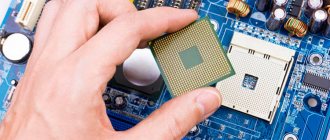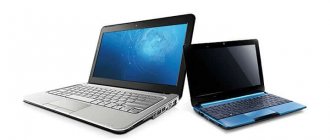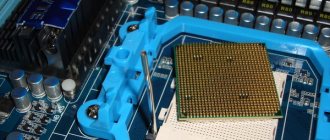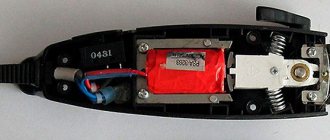As practice shows, in the modern world, many consumers choose a laptop instead of a desktop PC as a workstation. There is no point in describing the advantages of a mobile device, since they are obvious. We will talk about how to choose a processor for a laptop. This is an interesting topic, since store windows offer a huge selection of models from different manufacturers with different chipsets. At the same time, they differ not only in the manufacturer (there are only two), but in the labeling. You can, of course, trust the words of the seller when purchasing, but most likely, after a while it will turn out that the purchased device does not meet the goals that should be fulfilled. Therefore, a more logical solution would be to delve a little deeper into the topic of choosing a CPU and draw specific conclusions based on the knowledge gained.
Main characteristics of the processor
It is worth understanding that the processor (CPU, chipset, CPU) is not the only important element in a laptop, but it is the key one. Essentially, this is the brain of the device; it is responsible for performing all tasks. Even with high other indicators, a weak processor will not allow the gadget to show good performance.
Important! Changing the processor in a laptop is quite difficult. When a buyer is faced with the need to upgrade, many come to the logical conclusion that it is easier to buy a new device than to install a new chipset. It is for this reason that it is better to choose a high-quality CPU for a laptop than a large amount of RAM or hard drive, because these components are easy to change.
To understand how to choose a processor for a laptop, you should consider key indicators:
- company manufacturer;
- power consumption;
- Number of Cores;
- cache memory size;
- clock frequency.
To select a processor for a laptop, when purchasing, you should carefully look at all of the above indicators and find the best option. Below we talk in more detail about each of them.
Which laptop processor to choose: configuration options
Laptop for work and study
Let's start with undemanding tasks, such as working with documents in office programs, email, as well as surfing the Web through a browser and watching videos on Youtube and other services. For all this, a laptop with a Celeron, Pentium and Core i3 processor (in ascending order of needs) will be enough for you. When purchasing, you should pay attention to the processor version, so that the year of manufacture is newer and the system disk capacity is from 128 GB. As an optimal option, we offer three laptops with different processors for office performance, but with good equipment:
A laptop for everyday tasks and hobbies
For more serious plans, it’s worth looking at models costing more than 45,000 rubles, equipped with Core i5 or Core i7 processors. Such a laptop will allow you not to be nervous when a Windows update suddenly starts or when more than 3 tabs are opened in the browser. Of course, a lot depends on the modification of the laptop, but the best option is to choose models with at least 6 GB of RAM and an SSD as the system drive. All this can be purchased and installed later. So, we offer three laptop models with different processors, but with good equipment.
A powerful laptop for work and play
As we have already said, a power reserve never hurts, as long as the allocated funds allow. Let's assume that you are ready to pay from 70,000 rubles to 90,000 rubles for the machine you need. In such a laptop it is desirable to have a powerful Core i7 processor, a modern GeForce 1050 or 1060 video card and sufficient RAM (from 8 GB), as well as a high-speed SSD plus HDD. Here are three interesting proposals:
Manufacturer
In modern laptops you can find processors from two main manufacturers - AMD or Intel. They own about 98% of the market. The remaining 2% includes little-known chipsets with performance that cannot represent serious competition, as well as segmented models, for example, for military needs (Russian Baikal processor).
There is an opinion that Intel is superior to AMD in many criteria, and, as practice shows, this is indeed the case. Laptops with Intel chipsets heat up less, are less noisy, consume less energy, and show better performance and multitasking . It is worth understanding that this is a fairly generalized opinion, since none of these brands is limited to a couple of chipsets, there are a huge number of them, every year a new generation appears, which includes at least several dozen new models. Obviously, it is difficult to draw a single conclusion regarding manufacturers, since individual models may behave differently.
You should know that Intel processors are more expensive, but their price is justified. Some games are designed to work with Intel chipsets, which means they simply won’t run on AMD.
Interesting fact! Most gaming models with top parameters are based on Intel processors.
The disadvantage of the company is that the vast majority of chipsets cannot be overclocked, but, on the other hand, this is not necessary for them. AMD's disadvantages include increased power consumption, as well as slow operation of the second and third level cache, but at the same time they are cheaper. Sometimes this is an important criterion for the buyer.
Advice! To buy a truly powerful device, it is better to choose a CPU from Intel for your laptop. Not only store sellers, but also experts in this field agree with this. AMD chipsets are perfect for more budget gadgets and, depending on the tasks, can perform well.
The chipset lines and their purposes will be discussed in detail in the final part of this text.
Which processor should I choose and what will it be capable of?
The main manufacturers of processors for desktop PCs (including laptops) are Intel and AMD. Both companies release new processors every year with better performance and unique technologies. On the one hand, this is good - progress does not stand still, and there is movement forward. But along with new capabilities, the sockets on motherboards also change, which means an upgrade leads to an almost complete replacement of other components, the motherboard, memory and even disk drives. Although the interface of the latter is compatible with new and old CPUs, copying speeds over time cease to meet current needs. However, upgrading a laptop sometimes comes down to just adding more RAM and replacing the HDD with an SSD.
As for laptops, as you know, the processors in them are not replaceable and cannot be upgraded. This means that if you buy such a device, then you should choose immediately with a reserve for several years in advance.
In this regard, if you are not ready to spend money on a powerful device today, be prepared for the fact that in three years your laptop, focused on performing office tasks, will be very outdated and will irritate you with slowness in other areas, for example, in the browser or updated Windows.
Power consumption
The main advantage of a laptop is considered to be mobility and autonomy. The latter is achieved through a CPU with low energy consumption. The conclusion is quite logical: the less power the CPU consumes, the weaker it is. This conclusion is not only logical, but is a proven fact. However, don't think that every laptop has a low-performance chipset by default. Both manufacturers have different processor lines - with increased energy efficiency or, conversely, with an emphasis on power.
When purchasing, it is important to understand whether you need autonomy or power . A simple example: a consumer looking for a device for gaming will not have to use it in places where there is no power outlet. Obviously, it doesn’t matter to him how long the gadget runs on battery power, which means that in his case the appropriate type of processor is high power. If the device is purchased for work, and you have to move around a lot and use it while traveling, then performance will raise fewer questions, and an important criterion is that the device works for a long time.
Important! When purchasing, it is not necessary to look for energy consumption indicators for each chipset. Conclusions about its energy efficiency can be drawn from the labeling. This will be discussed in more detail below.
Graphic arts
Integrated graphics are the best solution for everyday tasks, but for gamers and users whose professional activities involve working with graphics, the best option is a dedicated graphics card, which provides better graphics and performance, and can also be replaced if necessary. If we consider the best integrated graphics chips, for example, UHD 630 and Vega 8, of course, they will run many resource-intensive games, but for professionals and avid gamers their performance will not be enough.
Number of Cores
The number of cores in a chipset is a point that is misunderstood by many buyers. Essentially, it is the kernel that performs different tasks. Two cores perform twice as many tasks simultaneously. It may seem that the more cores the better. But in reality, everything is not so simple, and a large number of cores is not a guarantee of high efficiency.
In chipsets with more than two cores, the cores are divided by task type. To simplify, we can say that in a quad-core processor the third and fourth cores have a narrow focus. For example, they are solely responsible for graphics. A buyer who just needs to surf the Internet or chat on Skype simply has no use for the two remaining cores; they will be inactive, which means he overpaid for them in vain.
The second point is the core frequency. The processor can have four cores of 1.5 GHz, which gives a total of 6 GHz, or 2 cores of 3.2 GHz, which equals 6.4 GHz at the output, which means the second option is better. Moreover, in the first option, all the cores will not work together, that is, the final frequency will not even be 6 GHz, but less.
Disadvantages of multi-core chipsets:
- increased energy consumption;
- inactivity of kernels if there are no specialized tasks for them;
- higher cost.
Advice! It is worth buying a processor with a large number of cores if the device is needed for games, working with graphics (designing, drawing, creating animated videos), and programming. If the buyer is pursuing the simplest everyday tasks - the Internet, casual games, online communication, movies, music, working in office applications, then the best choice would be a chipset with two cores, but with a fairly high frequency.
No. 9 - AMD Ryzen 7 5800U
The 2021 laptop processor comparison chart moves on. AMD Ryzen 7 5800U is a mobile processor that is often equipped with ultrabooks. It is based on Zen 3 architecture and operates at frequencies from 1.9 to 4.4 GHz. The model was produced using a 7-nanometer process technology. The chipset has integrated Radeon RX Vega 8 graphics with 8 compute units running at 2000 MHz.
The low TDP of around 15 W deserves special attention. In this case, the laptop manufacturer can independently configure it in the range of 10-25 W. The model's performance is commendable. It is absolutely enough for rendering 4K video, fast work of video editors and other similar tasks.
AMD Ryzen 7
Cache memory
What is a cache is an interesting question and not clear to many. To some extent, it may resemble an operational one, but of a much smaller volume. This memory contains the necessary information for the chipset. First, the processor accesses the cache memory; if the necessary data is not there, then it goes to the RAM memory.
The speed of the cache is much higher than that of RAM, which means that the information stored in it is more necessary. The larger the cache, the faster the processor runs. This memory has three levels. The first one is the smallest, but at the same time the fastest. The second has medium volume and medium speed. The third level is the largest and at the same time the slowest.
Important! The processor is better the larger its total cache size. At the same time, a large cache increases the cost of the chipset, and it will heat up more.
In devices for office tasks, the cache is most often 2-3 MB, this is enough for comfortable work, and the device does not get very hot. In gaming systems, its volume can be 8 MB, and it is logical that the cooling here is more serious, as is the final price.
The importance of RAM and cache memory when choosing a processor for a laptop
Another fundamentally important parameter for assessing performance is the amount of cache memory built into the processor. The fact is that the exchange of information between processor cores and cache memory is much faster than with RAM (random access memory). As a result, the larger the cache size, the faster your processor ends up being. Moreover, in real tasks, a large cache size is needed more often than additional cores or too high a frequency. However, the larger the cache memory, the more expensive the processor is . In addition, increasing memory leads to heating of the processor.
If we talk about a specific purchase, then when choosing a processor of the same series and line for multimedia systems and workstations, preference should be given to those with a larger cache memory.
CPU frequency
The last criterion on the list, but far from least important, is the processor frequency. This is the criterion that really affects performance and should be given attention. The principle “the more the better” works here. Processor frequency is a measure of how quickly it completes tasks.
Modern laptops with high-end chipsets have technology that independently regulates the frequency . Intel calls it Turbo Boost, AMD calls it Core Boost. This is done in order to save energy and prevent the device from overheating. The gadget understands the type of task, and if it is not difficult, it performs it at a low frequency, and when it senses the load, it intelligently raises the frequency to complete it faster.
When purchasing, you should consider what indicator is indicated on the price tag. Typically, sellers write the maximum frequency, that is, the one that the laptop is capable of delivering under high load, but its constant performance may be significantly lower. At the same time, the buyer does not plan to load the laptop, which means he will simply never reach that very high frequency.
Advice! It is recommended to look at the clock frequency, base and maximum. To do this, just make a request in any search engine.
Example: two chipsets with a frequency of 2 GHz and 2.3 GHz. At the same time, the first does not have frequency increase technology, while the second has it and produces only 1.7 GHz without loads. The buyer needs a gadget to work in office applications. In this case, you should buy a device with 2 GHz, since otherwise it will not use the maximum 2.3 GHz of the second CPU, but 1.7 GHz, which is basic for it. If the buyer is going to play, then he should choose the second option, since it will use all the power of the laptop, and the processor will produce the very necessary 2.3 GHz.
Comparison of Intel and AMD by prices
If you take such popular processors from Intel as Core i3, Core i5 and Core i7, and compare their prices with the popular A4, A6, A8 and A10 from AMD, and then combine the results in the form of a graph, the result will be as presented in the picture below.
Now you can clearly see the big difference in price. Processors from AMD are 3.5–4 times cheaper than Intel. Due to their low cost, AMD products are very popular both in Russia and in the CIS. With a small difference in performance, buying a laptop can save you a lot.
But on the other hand, an integrated graphics card from AMD can be a good solution for gamers. Just remember that such high-speed systems are subject to heating and significant consumption of energy resources. And if battery life is critical, then it's better to add a little money and buy products from Intel.
Processor lines and their purpose
So, the two main chipset manufacturers are AMD and Intel. How they differ was described above, but when comparing, you need to draw conclusions based on specific chipsets and their performance. You shouldn’t dismiss AMD by default; perhaps the available budget will allow you to buy the optimal solution on AMD, and not on Intel.
Both manufacturers have chipset lines that are updated every year. In this case we are talking about generations. Obviously, the logical choice is to go with a more recent generation, but you should understand that a processor from a higher line, but one generation older, may turn out to be better than one from a lower line, but more recent.
Important! Within a specific line there are divisions, they are indicated by markings. The type of laptop processor (energy efficient, mobile, productive) and the tasks it can handle depends on it.
Intel
Intel processors are divided into the following types:
- Celeron;
- Pentium;
- Intel Atom;
- Intel Core M;
- Core i (i3, i5, i7, i9).
The first two types belong to the class of low-power or aimed at performing everyday tasks. For the most part, these are dual-core chipsets without technology for increasing the clock frequency and multi-threaded operation (Hyper Treading). The latter means that if the CPU has two cores, but has Hyper Treading, then it works like a four-core one.
The Atom series are chipsets designed for tablets and smartphones, but can be found in small laptops 11-14 inches. On average, the performance is similar to the Pentium and Celeron series.
Core M is a relatively new line. Chipsets with average performance but reduced heat generation. Conventionally, they can be classified as an intermediate option - from Pentium to Core i. Suitable for simple office tasks.
Core i is the most productive line. The number after the i increases the power. So, in the i line, the weakest is the i3, the most powerful is the i9. The latest chipsets were announced in 2021; before that, the top solutions were i7.
Each generation of chipsets received its own code name - Kaby Lake, Haswell and others. You shouldn’t bother yourself with these names; just remember that the first digit in the encoding is a generation designation. That is, Core i7-7580H means that the chipset is 7th generation, that is, relatively fresh. There are currently 9 generations.
The second point that you should know and are recommended to remember is labeling. Each chipset has a letter suffix after the numeric code. The decoding of the letter designations is given in the table:
| Letter | Meaning |
| Y | Extremely low power consumption (11.5 W) |
| U | Low power consumption (15-28 W) |
| M | Mobile processor with average power and energy consumption (37-57 W) |
| Q | Quad core processor |
| H | High graphics performance |
| X | Top-end solution with high performance, designed for gamers |
| K | Overclockable processor |
| HQ | Quad-core processor with enhanced graphics |
Conclusion:
- Y is the most autonomous solution for those who need to work for a long time without charging, but at low or medium power, often installed in ultra-thin laptops (ultrabooks);
- U, M, Q – a medium option with good battery life and decent performance, a kind of universal chipset;
- H – emphasis on graphics, suitable for artists, architects and users of similar professions;
- K, HQ – game models;
- X is an extreme gaming option for eSports.
AMD
AMD chipsets also have several generations and lines. Generations are indicated by the first digit in the code. Currently, the newest generation of chipsets is labeled 9.
Below are the AMD processor lines.
- AMD Ryzen is a new solution with a Vega graphics card. Regardless of the type, discrete graphics cards allow you to play and perform resource-intensive tasks.
- AMD Athlon Vega – integrated graphics, but the chipset is simpler than Ryzen, designed for everyday tasks and fast response.
- AMD A is a segment without a built-in video card for a variety of tasks. There is a division within the series.
- AMD FX – gaming solutions without a built-in video card.
- AMD Ryzen Pro – best performance (gaming solutions, similar to the core i9 series with the X suffix).
- AMD Pro A – chipsets for business.
- AMD E – budget solutions for the simplest tasks.
AMD A series division:
- AMD A12 – high multitasking, emphasis on high-definition streaming video playback and online games;
- AMD A10 – energy efficient, high multitasking, HD content playback offline;
- AMD A9 – good performance with a focus on multimedia tasks;
- AMD A8 – multitasking and entertainment without focusing on games;
- AMD A6, A4 – simple office tasks.
Understanding AMD processors is quite difficult, but in most cases, users are faced with the A, E and FX series. The remaining chipsets, due to their novelty, are not widely used.
Advice! You should not consider the E line, since even basic tasks are problematic for them. Other CPUs behave decently if chosen correctly depending on the tasks.
Gaming flagship
Two models of laptop processors can compete for this title. One of them is the 7nm AMD Ryzen 9 5900HX based on the Zen 3 microarchitecture. The new “red” APU operates at a clock speed of up to 4.8 GHz, offers eight cores with multi-threading support and has a TDP of 35-54 W.
In turn, Intel Core i9-11980HK belongs to the top representatives of the Tiger Lake-H45 line. This is an 8-core / 16-thread processor with a clock speed of up to 5 GHz and a noticeably higher power consumption of 45-65 W.
Both processors show excellent performance in both single- and multi-threaded tasks, and, in simple terms, cope well with games, video rendering, and certainly with the banal viewing of YouTube while enjoying a cup of morning coffee. At the same time, the Core i9-11980HK works, albeit a little, but still faster than its competitor, providing 10-15% higher FPS in games.
The only problem with the Core i9-11980HK is that it consumes much higher power than the Ryzen 9 5900HX. And, if for desktop processors this is completely uncritical, then in the case of laptops it negatively affects their battery life. However, truly powerful gaming laptops have never been distinguished by high autonomy.
Socket
The socket or connector through which the processor is connected to the motherboard. Processor sockets are divided into classes depending on the form factor, which determines how the CPU is installed into a suitable motherboard. So, the sockets of the processor and the main board must be compatible, otherwise installation is impossible.
It is not worth considering the cheapest possible models if the efficiency of the device is important due to the obsolescence of the equipment.
Modern processors from AMD are compatible with the AM4 socket (slot for Ryzen processors), there is also a modification of TR4 for Ryzen Threadripper, and FX line processors compatible with AM3+ have not lost their relevance.
As for the CPU from Intel, the competitor’s specifications are already different; in the marking, the number indicates the number of contacts.
The easiest way to determine the compatibility of component devices is by looking at this information on the manufacturer’s website. Intel's current slots today are 1151v2 and 2066, the latter is expected for top-end assemblies.











